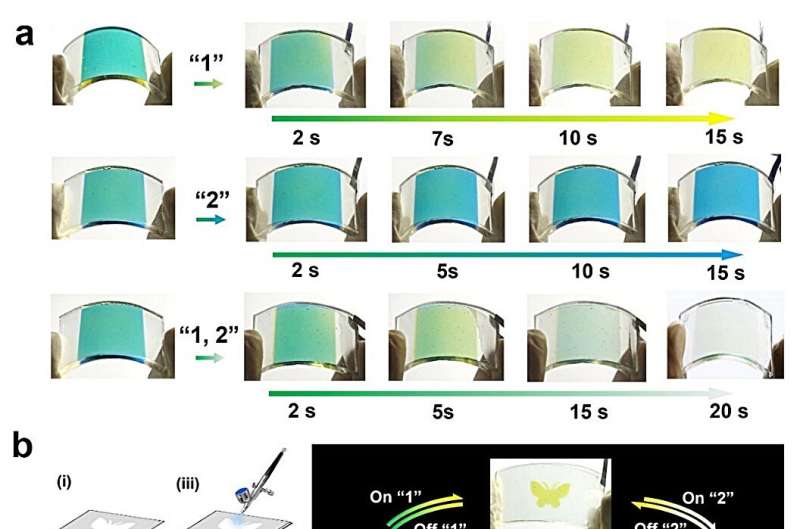This article has been reviewed according to Science X's editorial process and policies. Editors have highlighted the following attributes while ensuring the content's credibility:
fact-checked
peer-reviewed publication
proofread
Self-powered flexible multicolor electrochromic devices for information displays

In recent years, self-powered electrochromic (EC) devices have shown significant potential in various fields such as optoelectronics, sensors, and security systems. These self-powered EC systems, capable of reversible color switching without external power sources, have garnered considerable interest for next-generation electronic devices.
However, this field is still in its infancy, with several unresolved challenges, including monochromatic displays, limited cycle durability, and the use of aqueous electrolytes. All these limitations have become a big bottleneck for further smart applications of self-powered EC systems. The primary challenge is to develop appropriate EC cathodic materials that can exhibit independent self-powered color switching behavior under the same working parameters.
Since Prussian blue (PB) has excellent EC properties and shows great potential in the self-powered EC system, we envisage that Prussian blue analogs (PBAs), such as nickel hexacyanoferrate (KNi2+[Fe3+(CN)6], NiHCF), are promising self-powered EC cathodic materials because PBAs have the similar face-centered cubic crystal structure and redox reaction with PB.
Moreover, previous study shows that PBAs with various color are easily attainable by changing the transition metals to coordinate with cyanide ligands, providing a potential library for designing self-powered multicolor switching system. In addition, color display applications of the self-powered EC systems generally require creating specific patterns in the EC films to convey information.
Lithography platforms are feasible to create complex patterned EC devices, however, this approach requires predesigned photomasks and complex fabrication steps. We address this issue by introducing a rapid and straightforward spray-coating method for uniform NiHCF and PB nanoparticle film fabrication. This approach enables the creation of self-powered multicolor EC displays with patterns, enhancing their capacity to convey specific information.
The research team at the University of Jinan, led by Wenshou Wang, presents a design principle for a self-powered flexible multicolor EC display based on a trilayer film structure. This structure comprises an ionic PAM/LiCl gel film sandwiched between NiHCF and PB nanoparticle films acting as two EC cathodes. NiHCF and PB nanoparticles are sprayed onto cleaned ITO/glass to create independent self-powered color-switching cathode films.
Specifically, the initial EC system exhibits a green color owing to color overlay of the top yellow EC film (NiHCF) and bottom blue EC film (PB). By connecting/disconnecting an Al wire between NiHCF nanoparticle film or PB nanoparticle film and gel film, the EC system exhibits a color switch between green, blue, yellow and colorless.
Additionally, a self-powered flexible multicolor EC display is developed using ITO/PET as substrates, offering a simple fabrication process for patterned multicolor displays, which holds promise for applications in displays and anti-counterfeiting measures. Furthermore, a self-powered ionic writing board is created, enabling freehand writing without external power using LiCl/PAM aqueous solution as ink.
In summary, the self-charging capability of EC displays ensures their continuous use for self-powered color switching without external power sources. The current system offers significant advancements in multicolor switching, with options for green, blue, yellow, and colorless displays, along with fast response times, high reversibility, straightforward operation, simple fabrication processes, and high flexibility.
These results present a novel approach to designing self-powered flexible multicolor EC systems, significantly expanding their potential applications.
The research is published in the journal Research.
More information: Wenzhao Xue et al, Self-Powered Flexible Multicolor Electrochromic Devices for Information Displays, Research (2023). DOI: 10.34133/research.0227
Journal information: Research
Provided by Research



















